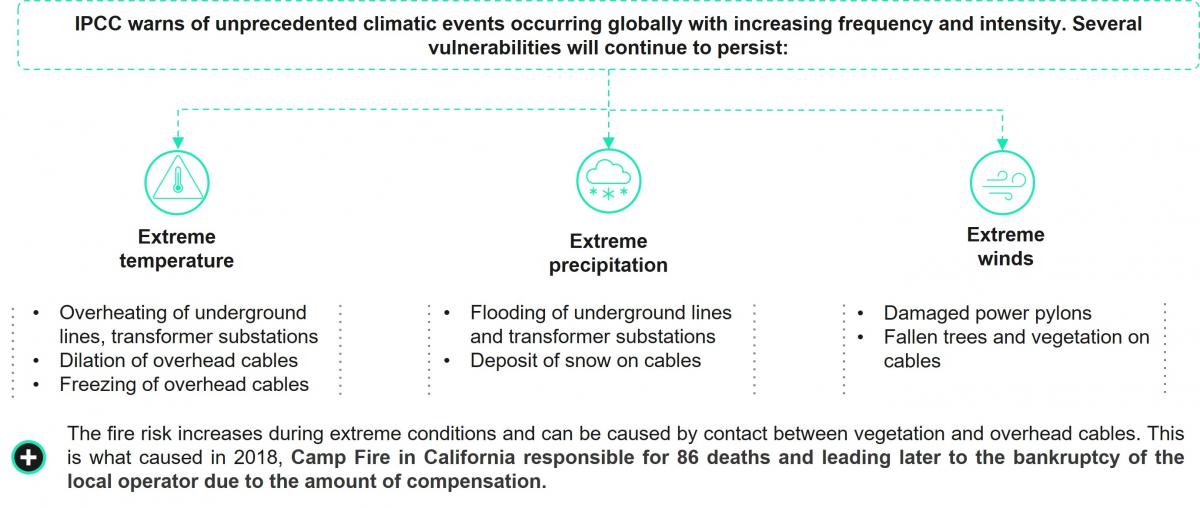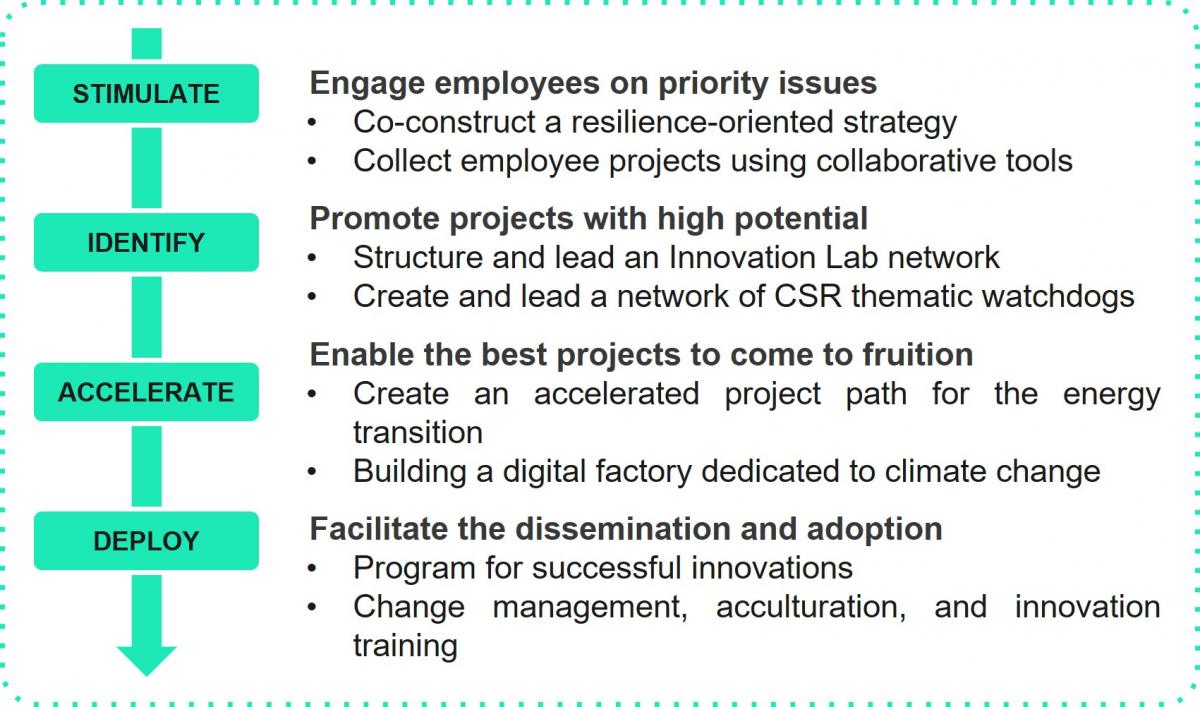Canadian Hydrogen Observatory: Insights to fuel…

Unprecedented climatic events are likely to increase in the coming decades. Higher temperatures, heavy precipitation, and rising sea level constantly threaten the electricity network and force operators to adapt and improve their grid resilience.
In August 2021, the IPCC warned of the unprecedented climate changes raging globally with increasing speed and intensity. Human-generated greenhouse gas emissions have increased the global temperature by 1°C since the Industrial Revolution. Studies have proved a direct link between human-related CO2 emissions, climate change and extreme weather events such as droughts, fires, acidification of the oceans and rising sea levels.
The acceleration of the occurrence and intensity of extreme climatic events represents a multitude of risks for energy systems. Extreme temperatures, precipitation and winds cause numerous breakdowns of the electricity networks. Operators are potentially facing large amounts of deterioration or even destruction of their infrastructure. These companies are currently losing income and they need to mobilize emergency teams in order to fix the electricity grid of households, businesses and industries.

However, solutions can be found to improve grid resilience and, therefore, save energy and cost. To counter increasing climate events, energy companies are adapting themselves by developing new practices, strengthening their infrastructure and guaranteeing a continuous and secure supply.
Firstly, actions can be implemented to reduce the vulnerability of grid equipment by strengthening the infrastructure depending on its location. On February 17, 2022, Storm Eunice struck England, Northern France, and Germany. These countries were crossed by violent winds, some of which exceeded 180km/h, and were responsible for the death of 16 people. The transport and distribution network infrastructures were badly impacted: hundreds of pylons were damaged or knocked down; transformer stations ran out of service. Uniper’s Grain station in Kent which produces power for more than one million homes was forced to shut down as strong winds knocked down a chimney. At least 226,000 homes were left without electricity and insurers estimated the damage at more than £300 million. 46,000 km of overhead lines were damaged in more than 1,800 locations.
The mobilization of the engineering teams led to the restoration of most of the electricity network in England. Power was restored to the vast majority of homes within 48 hours. However, more than 3,000 households did not regain access to electricity for a week, prompting the government to order a review of utility firms’ preparedness. Operators' ability to restore power supply was made at a very high cost and took time for some regions. The storm has also demonstrated that electricity networks are vulnerable to major meteorological phenomena. As the frequency and intensity of these extreme climatic events are likely to increase, the network must be able to keep up. TSOs are investing each year to adapt and reinforce the network. This includes upgrading, maintaining, and permanently checking the conditions of the assets regarding the environment around them. Pylons are built with specific materials in wind-exposed regions and their foundations are reinforced in stressed climate areas. Vegetation management is considered in defining the location of new infrastructure to avoid the risk of contact between trees and cables.
With the frequency of extreme heat waves expected to increase in the future, electricity networks need to be prepared. The 2022 IPCC report predicts an increase of 2,7°C degrees by the end of the century. High temperatures expose the transmission and distribution network to damage. This results in efficiency and economic losses for the operators. To counter this issue, DSOs identified various measures to adapt their network. Among them, they increase the height of poles supporting power lines, install conductors with hotter operating limits, and implement the use of “low-sag” conductors. A voltage sag is a short-duration reduction in the voltage of an electricity power distribution system. It can be caused by high current demand and is the most common cause of poor power quality. This problem can be resolved by lowering the voltage drop. Indeed, low sag conductors enable to increase the transmission capacity by 1.6 to 2.0 times without the replacement or reinforcement of existing towers. In addition, renewing the insulation of underground cables to reinforce the resistance of the lines during heat waves in exposed regions.
The formation of specially trained reserve teams equipped with the appropriate tools is a crucial point that needs to be considered by operators to better prevent crises. Operators need to have human forces and specific tools to deal with all the potential damage that threatens the network. As soon as a storm is forecasted, network operators deploy special teams ready to go on the ground.
TSOs and DSOs have therefore set up response teams. For instance National Grid has organized these crisis units in different levels (bronze, silver, and gold) depending on how severe the situation is. Composed of qualified employees, they have the ability to put in temporary generators and flood defenses. They can also obtain helicopters and specialized equipment that is easily transportable. Vehicles and equipment are moved to strategic locations to reduce the time to step in. Strategic locations can be big substations or remote parts of the network heavily exposed to extreme climatic events. Crisis units respond to issues during the event and follow up on all sites to complete damage assessments. Engineers on the field are in constant contact with the Transmission Network Control Center (TNCC).
Finally, leveraging tools that help to predict extreme climatic events allows operators to strengthen their resilience. The use of digital technologies makes it possible to make networks smarter and better prevent risks. The operators need to equip themselves with forecasting tools and meteorological alerts.
Previously, TSOs and DSOs relied mainly on operational experience from engineers on the ground to prepare extreme climatic events. Recently they include more and more Big Data and analytics to make much more accurate and targeted precisions. In 2014, National Grid co-constructed with the Massachusetts Institute of Technology a tool called Predictive Storm Damage Model. This computer model uses real-time data and advanced forecasting models to predict to which degree a part of the network can be impacted and then calculate the best response. In addition, the network operator has set up a digital mapping program that enables engineers on the field to directly report toppled poles or downed lines in real time.
TSOs and DSOs also rely on innovation to overcome challenges caused by extreme climatic events. They have digitized their inspection regime using aerial LiDAR (a laser scanning remote sensing technique which is highly accurate and suited for topographic surveys of vegetation or hard access zones) and drone footage image processing technology. This new process of surveillance aims to significantly increase the productivity of the field operations and support better decision making when planning the work to operate on the electricity network.
The Data Science approach can assess the risk on any equipment of the grid.
Sia Partners has already supported grid operators with similar methods and could therefore contribute to a better assessment of grid vulnerability to climate change.
Better risk assessment is a key component of asset management and integrating climate risk into investment or business decisions is becoming more crucial. To do so, grid operators need to rely on indicators and cartographic tools that support decision-making. For instance, analyzing the network at different levels could help to trigger investments to prevent cascading failures due to extreme events or to adequately prepare upcoming crisis units.
Experiments to improve the grid resilience are paving the way for industrial deployment. Operators can leverage public funding to support their grid adaptation experiments or the development of digital solutions. Sia Partners can guide them through the scoping of relevant funding windows and the application form compiling.
At the industrial deployment stage, a proper program management onboarding Engineering departments and IT department is needed for continuous improvement, control of project delivery times, and cost control. With many similar credentials Sia Partners can support operators in the management of a grid resilience program.
The implementation of a resilience program required a strong adherence from key departments. Sia Partners can support operators in driving change and managing skills by:
We also believe that innovation is key to feeding long term programs with concrete and efficient solutions. To bring results, we propose an end-to-end approach focused on the resilience to climate change and which follows 4 steps:

This end-to-end approach builds on one of the existing resources of your company: employees. This potential needs to be stimulated, that is why implementing a CSR network, an innovation management system and a collaborative mindset among your teams are solutions Sia Partners have been mastering in the last years. Employees can create today innovative solutions your company needs to face climate change. This material then needs to be transformed and finally deployed into industrialized innovations oriented for grid resilience.
Sia Partners blends its competences in innovation management, data science, design thinking and change management to make the most out of your ecosystem. People, startups and local authorities as industrial partners are a part of your answers.
In case of extreme weather events impacting the grid, ensuring customers are reconnected in the shortest time and at the best cost is key.
Operators can leverage remote monitoring to precisely locate faults and trigger relevant actions:
→ Use of outage data from smart meters to identify the precise locations of malfunctions and thus be able to intervene more effectively
→ Use of data science and business expertise to interpret more complex data and improve the accuracy of fault location.
To go further, Sia Partners has used AI to learn fault patterns and predict defaults on the next day due to weather conditions.

By leveraging these technologies, grid operators can reduce the intervention time: resources could be allocated at the right time and location. However, technology alone is not enough. To be effective, operators need to rely on an operational organization that allows employees to make the right decisions and implement them easily. Change management is therefore part of any data science solution to improve resilience.